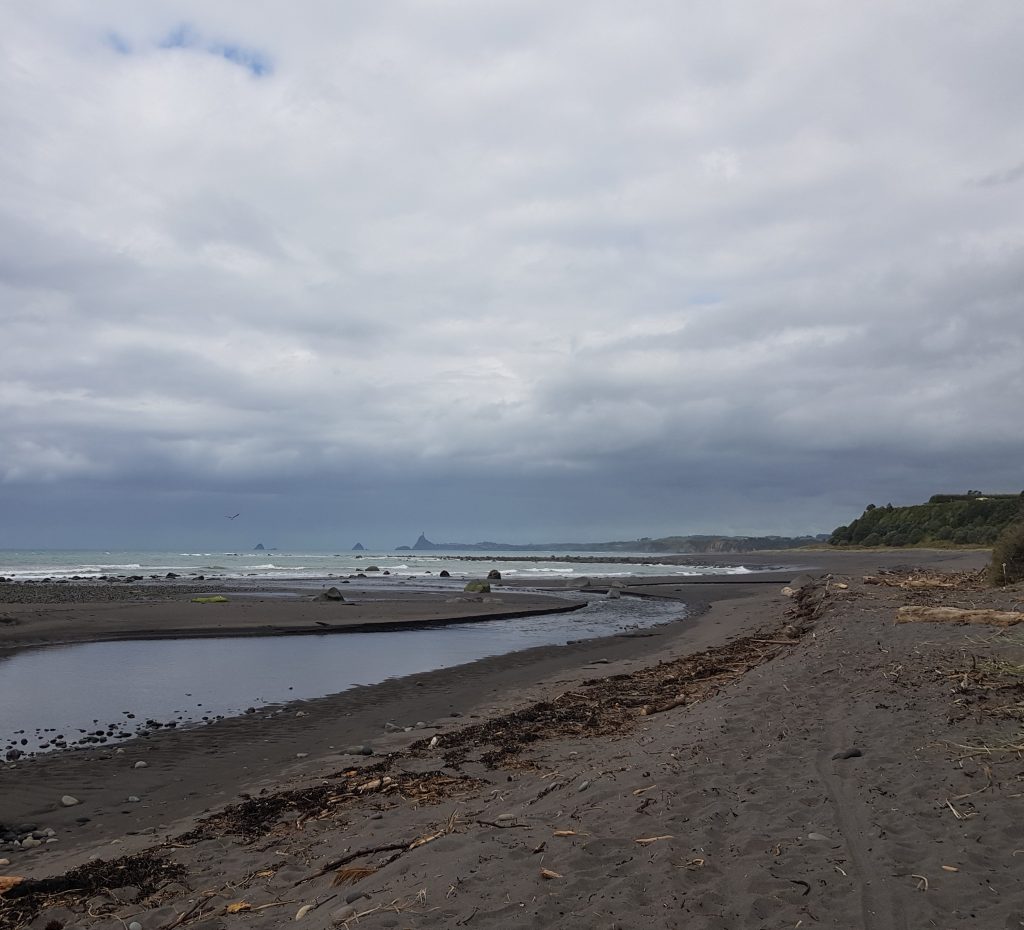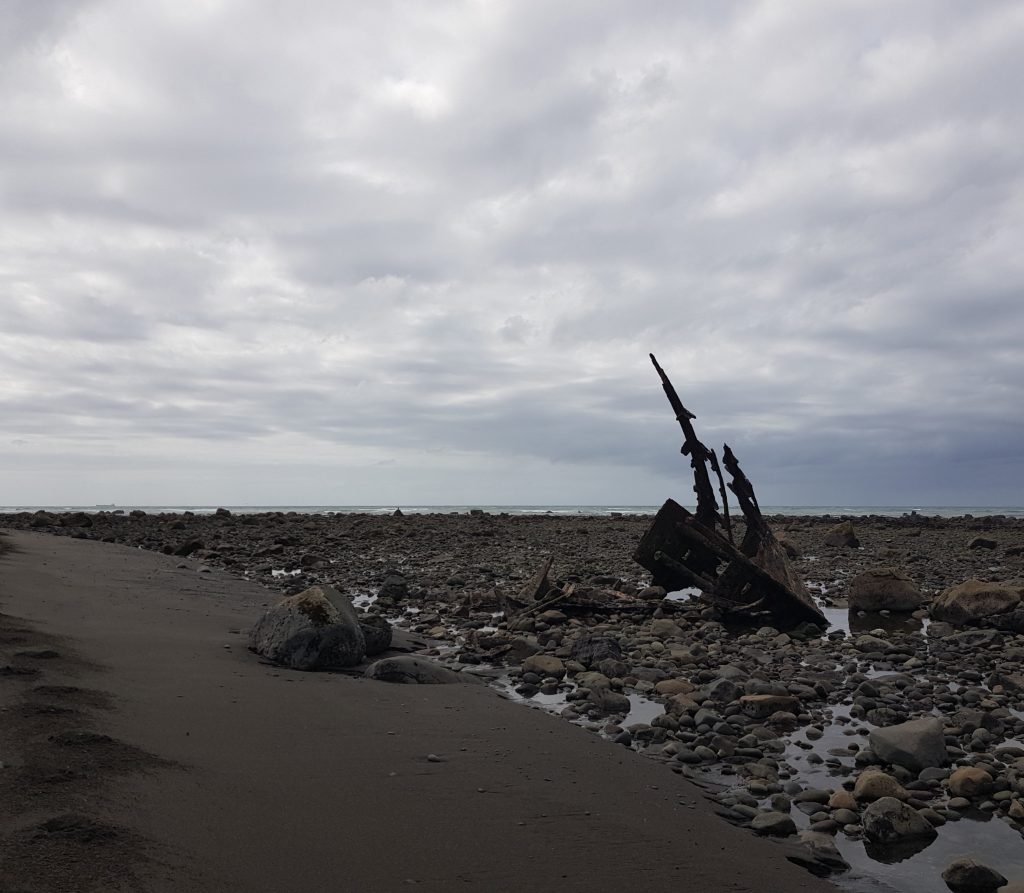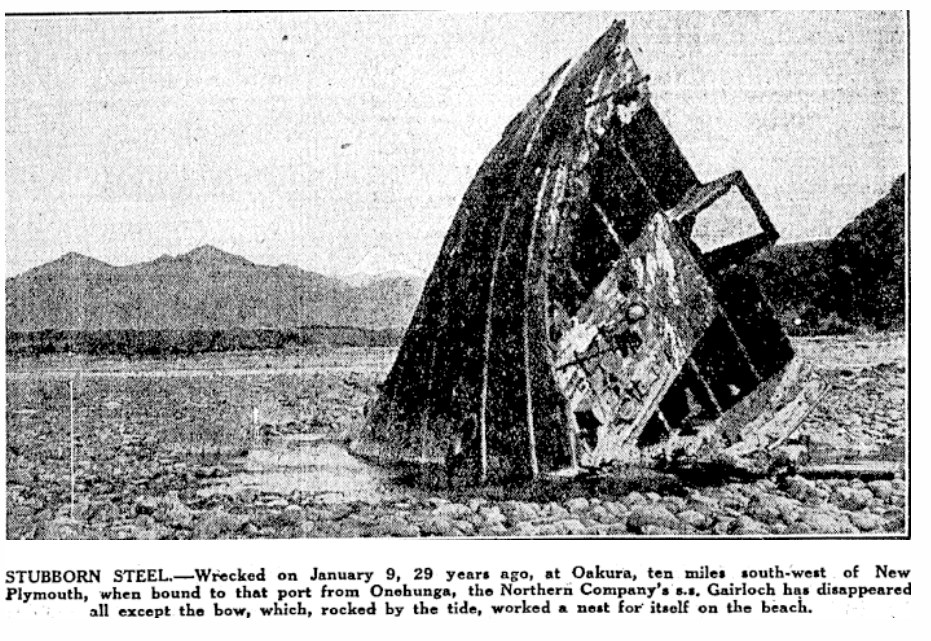I was in New Plymouth on ancestry business, but that didn’t mean I couldn’t take some time out to visit a shipwreck site, even if it had nothing to do with my venerable forebears. So after getting some directions from a local I left Auntie at the library and set off to locate yet another of the rusting wrecks that litter our Kiwi coast line.
I headed out of New Plymouth and through Oakura, before turning off at Weld Road. As promised, a car park awaited me at its terminus from which I had easy access to the beach. There was only one problem – the Timaru Stream outlet was blocking my way.

I searched fruitlessly for a shallow place to cross, but in the end was forced to accept the inevitable wet feet – the second time I’d thoroughly soaked my shoes since arriving in Taranaki. At least this time it was only my shoes.
As I crunched across Taranaki’s famous black sand, I scanned the shore for any sign of the wreck. My notes included the warning “only visible at low tide” and I hoped I’d timed things right. Finally I spied a suspiciously pointy shape jutting out from a rocky shoal in the distance and decided – in the absence of any better plan – to head toward it.
It seems my plan was fairly sound, as I was soon able to discern some clearer details.

The Gairloch was built at Glasgow in 1884 by Messrs Blackwood and Gordon for the Northern Steamship Company. The 45 metre long steamer’s purpose was to carry cattle, passengers and cargo between the northern ports of New Zealand. For this purpose the vessel’s hold was fitted up with stalls and a ventilating machine, “capable of extracting 300 cubic feet of foul air per minute”. In addition she provided first class accommodation for 40 passengers, and second class accommodation for 12. She arrived in New Zealand in January of 1885, after journey of 115 days.
She was quickly put to work plying the west coast ports of the North Island, and when she first pulled in to Waitara (painted a “lively green”) she caused quite the sensation, with Captain Findlay McArthur gallantly greeting the throngs of curious sight-seers keen to examine the new vessel. It was noted that the ladies were particularly impressed by the “white and gold fluted panelling and scarlet drapings” that decorated the saloon.

Considerably less impressive was the unfortunate predicament she found herself in upon attempting to depart, striking the river bar and becoming stranded overnight. Luckily the only damage was to the captain’s pride, and the Gairloch was able to continue her journey unharmed.
To be fair, the Waitara Bar is a notorious obstacle that has been implicated in innumerable strandings, and at least 19 vessels have been lost on or near the bar. This would also not be the last time it would happen to the Gairloch, as it was stranded in the same place again in 1887, and again in 1889.
It seems like in 1894 something occurred that caused the Northern Steam Ship Company to suspend Findlay McArthur, who was bankrupted not long after. No further news appears about the man until 1899 when the ship he was captaining, the Wolverine, was lost at sea.
At the time of the Gairloch’s untimely end in 1903 her master was Arthur Henry Austen, who’d had a long career with the Northern Steamship Company, previously as captain of the Glenelg. On Saturday 3 January 1903 she left Onehunga, bound for Raglan, Kawhia, Opunake and Whanganui. She was carrying twenty crew and a cargo of sugar and timber but no passengers.

She left Kawhia at about 2pm on 5 January, and though the sea was comparatively calm, soon rain was pouring in sheets. As she passed New Plymouth the evening was so murky that she narrowly avoided colliding with her sister ship the Ngapuhi as it left the port of New Plymouth. Only the blare of whistles staved off disaster as the two ships passed each other in the gloom.
Sadly this narrow miss was an omen of what was yet to come, for at twenty minutes to midnight the crew of the doomed Gairloch felt a lurch and soon found themselves stuck fast. They sent up distress flares which were noticed by settlers in the locality – who alas were powerless to render any assistance.
The light of dawn allowed the crew of the stricken ship to take their boats to the New Plymouth breakwater, which they reached at 6.30am. The fact that Miss Stanley the stewardess was able to disembark without assistance was touted as a sign that nobody was worse for wear.

The crew were fed and housed at the Breakwater Hotel, Moturoa, while another local sent a supply of socks just in case.
In the cold light of day it was plain to see that the ship was unsalvageable. The rugged reef had torn out her bottom and she listed to and fro with the tides, breaking up further. Immediately efforts began to recover any cargo that could be saved, though rough seas over the next few days resulted in some of it being washed away and by the 16th all that was left had been thoroughly destroyed by the ocean. The Company did not insure its vessels, so was forced to swallow the loss – though their policy on that soon changed, go figure!

A court of enquiry found that the master had made an error in hugging the land so closely in the dark of the night, and suspended his certificate for three months as well as having him pay £10 toward costs.
What remained of the ship was sold by auction as-is where-is and fetched a mere £20, while the ruined cargo was sold to another bidder for 5s. By April of that year between the sea and the salvagers there was very little of the once-proud boat left to be seen – and yet remarkably that little has persisted for over a century.

This rusted hull on this reef serves as a reminder of New Zealand’s dangerous waters, and of the days when sea travel was a necessity, when a new steamer to ply the coast was a matter for excitement and celebration.
These days aeroplanes and fossil-fuel burning vehicles do the job that steamers like the Gairloch once did, but I can’t help but feel change is once again afoot, and in another century such things may well be viewed with the exact same curious nostalgia.
References:
New Zealand Shipwrecks 1795-1960 by C.W.N Ingram and P.O. Wheatley
SHIPPING. New Zealand Herald, Volume XXII, Issue 7235, 26 January 1885
ARRIVAL OF S.S. GAIRLOCK AT WAITARA. Taranaki Herald, Volume XXXIII, Issue 6678, 11 February 1885
SHIPPING. New Zealand Herald, Volume XXII, Issue 7251, 13 February 1885
The Gairloch Ashore. Star, Issue 6653, 19 September 1889
LATE TELEGRAPHIC. New Zealand Mail, Issue 1167, 13 July 1894
Untimely end for steamer by Graeme Duckett
WRECK OF THE S.S. GAIRLOCH. Timaru Herald, Volume LXXVIII, Issue 11959, 7 January 1903
Wreck Near Oakura. Taranaki Herald, Volume L, Issue 12160, 6 January 1903
INTERPROVINCIAL ITEMS. Evening Post, Volume LXV, Issue 127, 30 May 1903
Local and General. Wanganui Chronicle, Volume XXXXVII, Issue 11810, 15 January 1903
Untitled Auckland Star, Volume XXXIV, Issue 14, 16 January 1903
Local and General. Patea Mail, Volume XVI, Issue 199, 24 April 1903




there is a lot of information and general information in the book “Servants of the North ” which is the history of the Northern Steamship Company and well worth reading if you have even the slightest interest in coastal shipping (mainly the North Island)
Please keep on writing these blogs, they are unique.
I see that you mention the jobs of steam ships have been replaced by “fossil fuel burning vehicles”. I infer a hint of negative judgement there. Would I be correct in assuming that black smoke issuing forth from the ship’s funnel might well be the product of the combustion of coal? Isn’t coal a worse polluter than hydrocarbon fuels in that it is mostly carbon? Just saying.
It is awesome that documentaries are written for this tragedies. Still gives me that vibe even though we have read stories like this already.
peter
https://www.electricianhamiltonnz.kiwi/